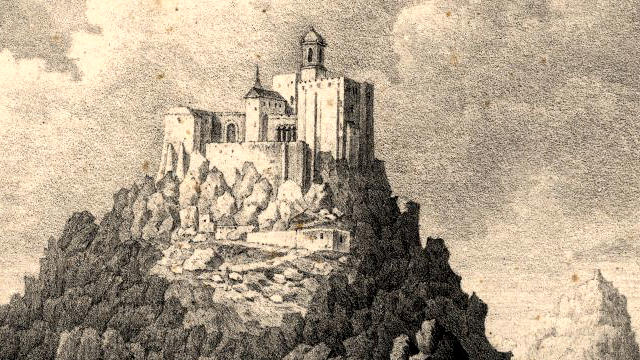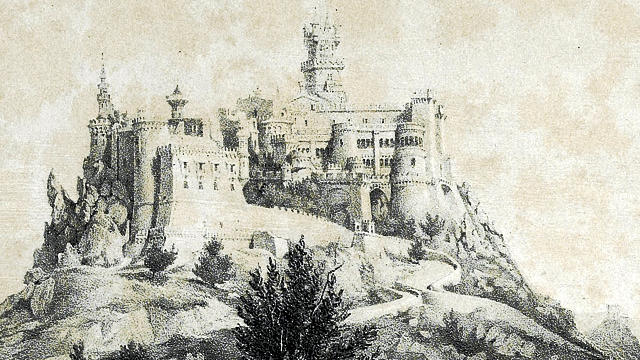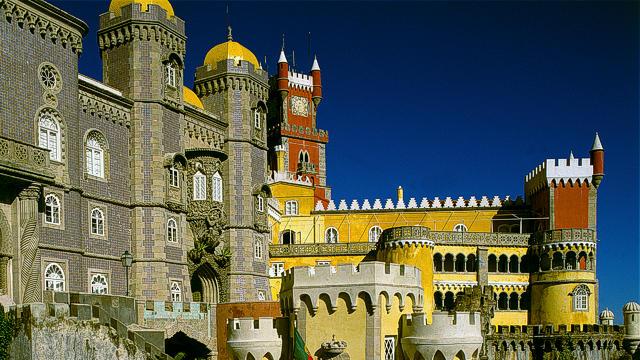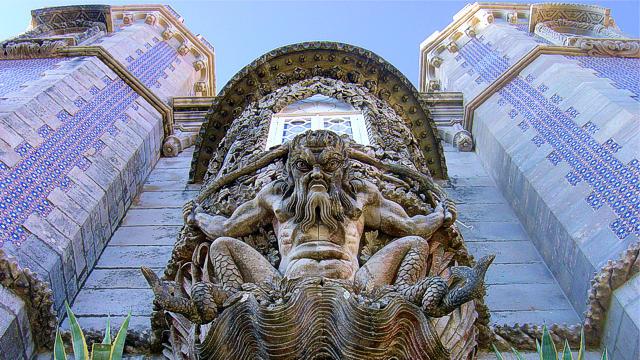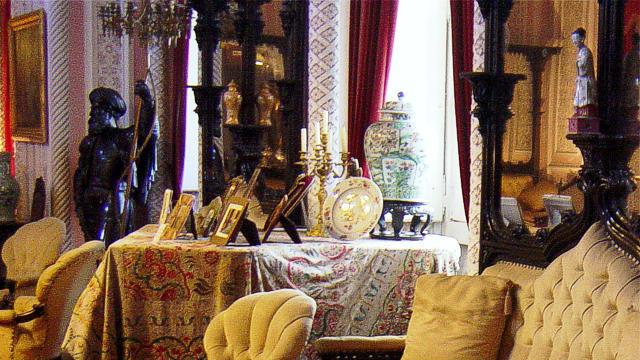Pena National Palace
Pena Palace is the most notable example of Portuguese architecture in the Romantic period
Fanciful to an extreme, the architectural fabric of Pena finds much of its inspiration in the Moorish, Gothic and Manueline motifs of Portuguese art (red buildings), as well as in the Wagnerian spirit of the Schinkel Castles of Central Europe (yellow buildings).
It stands on one of the rocky peaks of the Serra de (Mountain of) Sintra and blends in a fortunate manner with its natural background of greenery and crags.
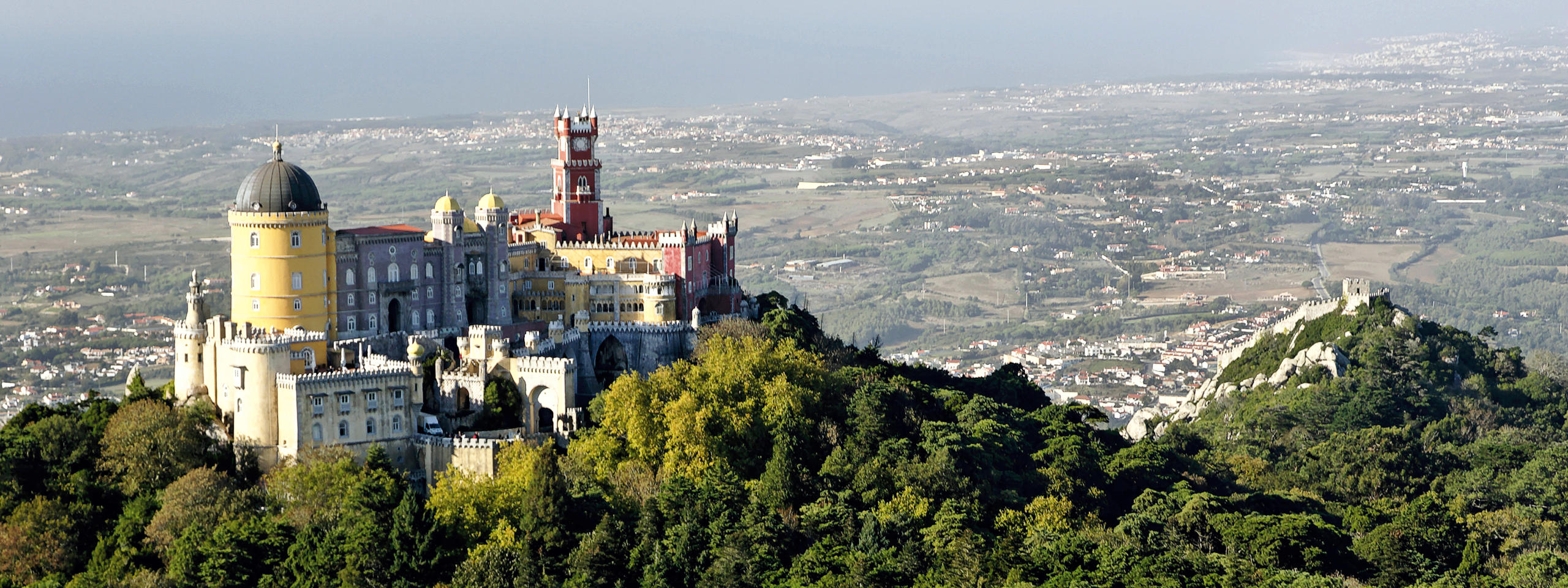
Birdview of Pena Palace with the ocean in the background and the Castle of the Moors hilltop on the right

Sundial and cannon (used to fire automatically everyday at noon) on the Queen's terrace
History
A pilgrimage site since the Middle Ages, the chapel of Our Lady of Penha was replaced by a Hieronymite monastery whose foundation was authorised in 1503 by King Manuel I (1469-1521), the monarch during the great Portuguese discoveries.
The monastery was greatly damaged by the 1755 earthquake and finally abandoned after the nationalisation of the monasteries in 1834.
In 1838, German Ferdinand Saxe Coburg-Gotha (1816-1885), King Consort of Queen Maria II , bought the ruins of the monastery, the woods and the Castle of the Moors, 0.80 square mile (200 hectares) all together, and initiated the construction of a road that would link the palace to Sintra.
The remodelling of the old monastery (red buildings) began in 1840 and, around 1845, Ferdinand extended it by building another complex (yellow buildings) which was known as the "New Palace" inspired by the palaces and castles of Bavaria.
The German architect Baron von Eschwege was in charge of the remodelling and the new construction.
It became the summer residence of the Royal family.
Under his explicit command, the monastery was painted in red and the new building in yellow.
In 1994 the original colours, which disappeared with time, red for the former monastery and yellow for the new palace were restored.
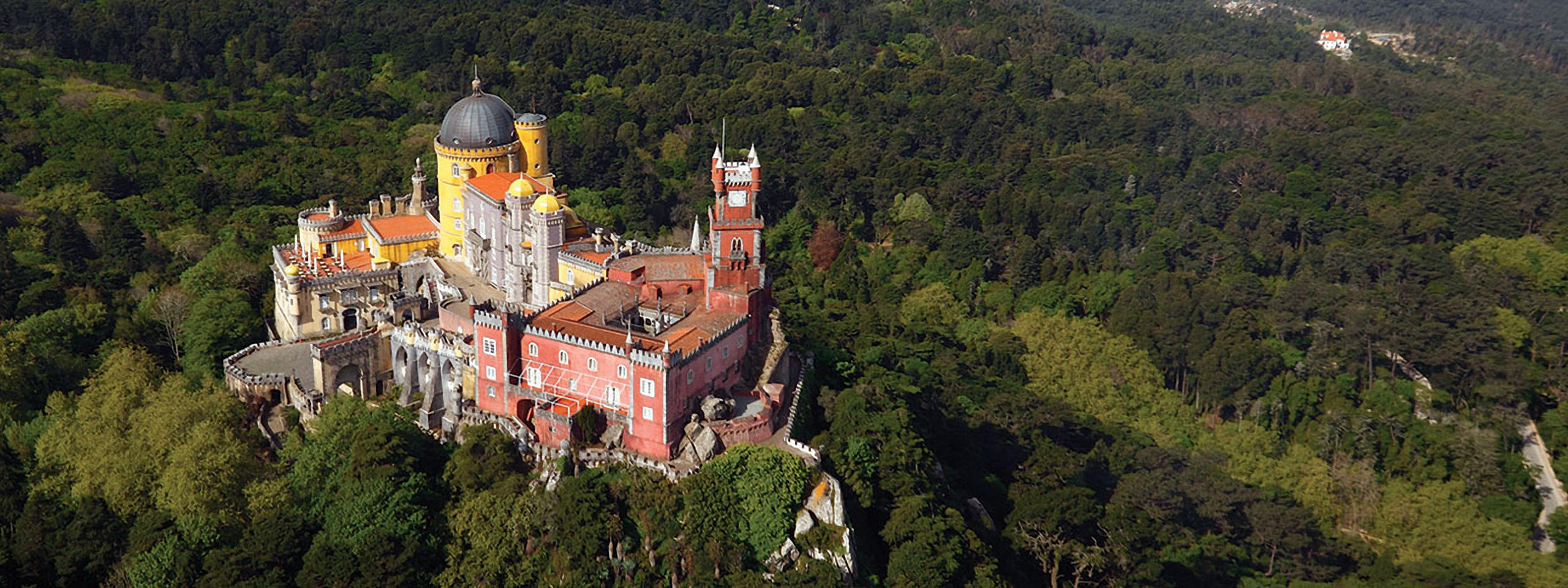
Birdview of Pena palace (Old remodelled Monastery in red and New Palace in yellow)
Styles
This astonishing castellated building standing on rocks beautifully portrays the Romantic esprit of the 19th century. Combining national decorative elements (Neo-Romanesque , Neo-Gothic , Neo-Manueline with the Oriental styles (Neo-Moorish and Indo-Gothic ), its eclectic medley of drops, towers, small turrets, terraces and others creates a harmonious whole that is unique in South Europe.
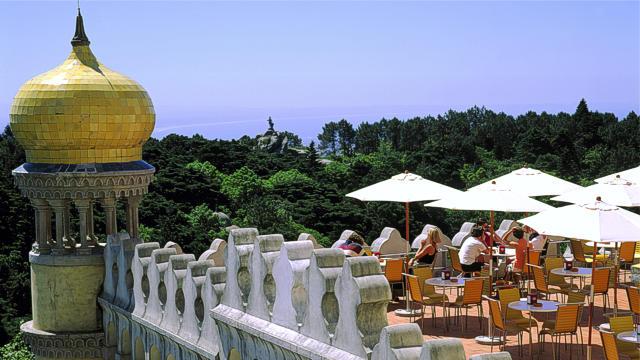
Terrace featuring a neo-Arab turret with the Statue of the Warrior in the background
Features
Among the countless striking features of the palace :
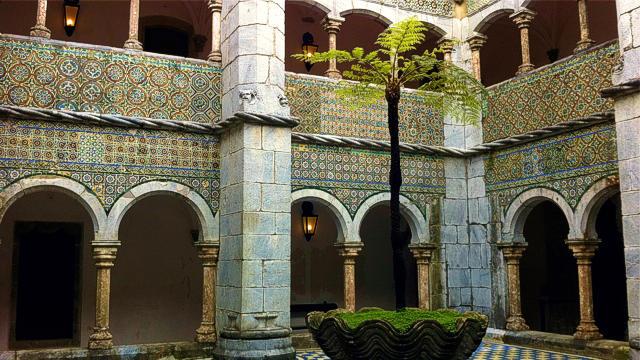
Manueline cloister preserved from the old monastery

Chapel altarpiece alabaster and marble reredos by French sculptor Nicolau de Chanterenne commissioned by King John III (1502-1577), 30 years before similar constructions appeared in Bavaria
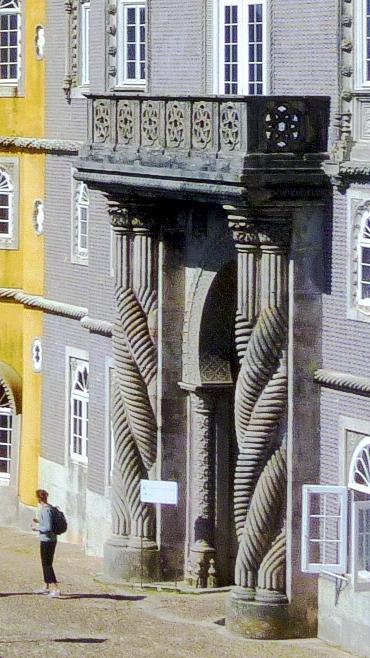
Twisted Columns sustaining the balcony of the Auditorium

Noble Hall
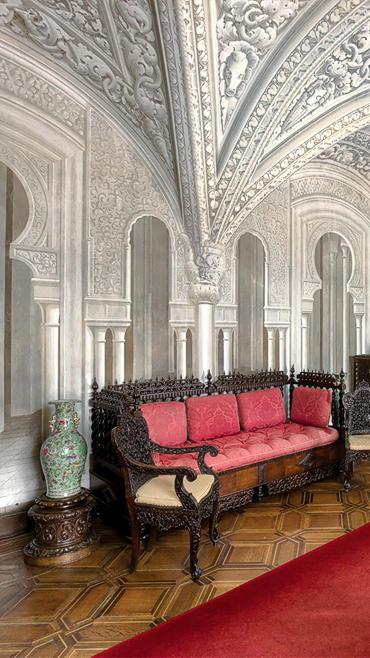
Luxuriously decorated rooms (here the Arab Room) exhibit marvellous trompe-l'oeil frescoes
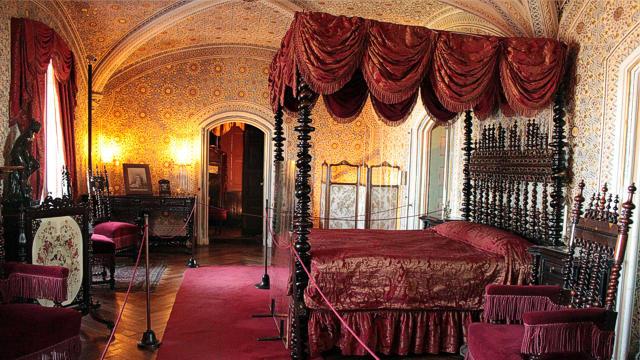
Walls covered with 19th century tiles (Azulejos ) by Wenceslau Cifka, Ferdinand's personal friend
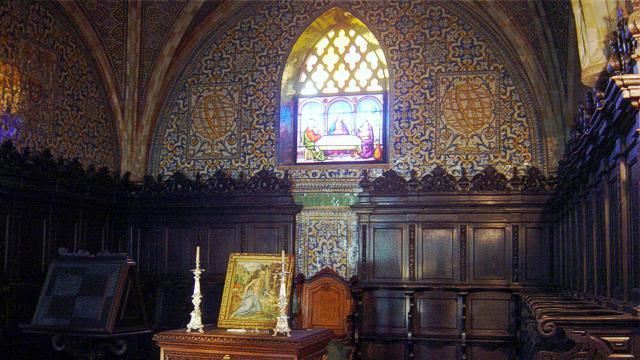
Chapel preserved from the old monastery
The Park
This shady park, covering an area of some two hundred hectares round the Palace, was planted with trees in the third quarter of the 19th Century.
Created by King Ferdinand II, it is a natural prolongation of Pena Palace itself, with its thirty-odd constructions and an enormous variety of exotic plants from the farthest corners of the earth, which mingle with the autochthonous vegetation in an exuberance of greens and scents.
It is one of the most attractive places on the Serra de (Mountain of) Sintra, owing to the spell of romanticism that emanates from its greenness and the wide stretches of countryside that can be glimpsed from it.
The way that the trees have been arranged in contrasting clusters, setting off to advantage the delicate note of the gardens, the graceful curve of a path, or the sudden view of a pond, all show the artistic intent that governed the planting of this park.
Cruz Alta (High Cross)
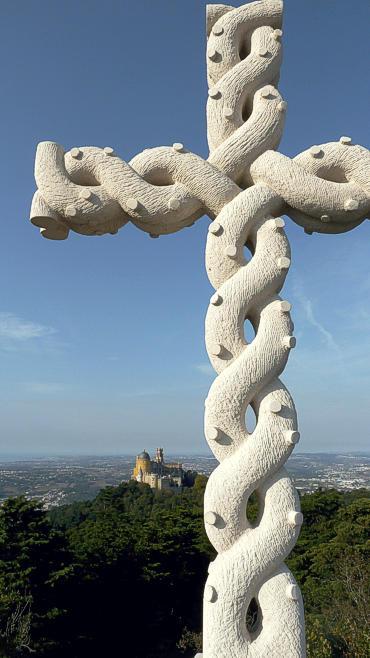
The highest point on the Serra (mountain) at 540 metres, with its 16th Century cross (1522) and panoramic all-round view that embraces the fantastic ensemble of the romantic Palace. It is a place that should on no account be missed by anyone visiting the Pena Park
Countess Edla’s Chalet
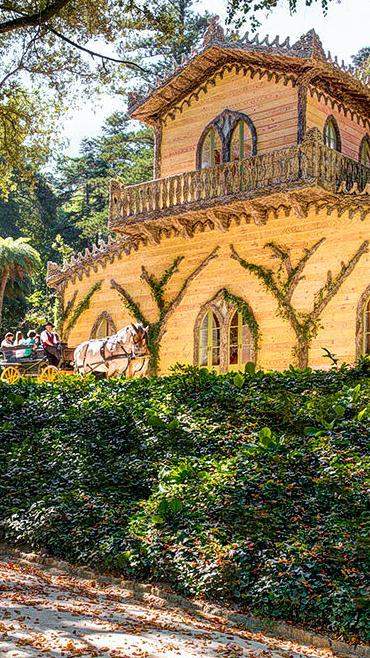
Built by Ferdinand, one year after his second marriage to the Swiss-born American opera singer Elise Friedericke Hensler, Countess d'Edla , it was designed by her, inspired by Swiss chalets and rural houses of the United States
Statue of the Warrior
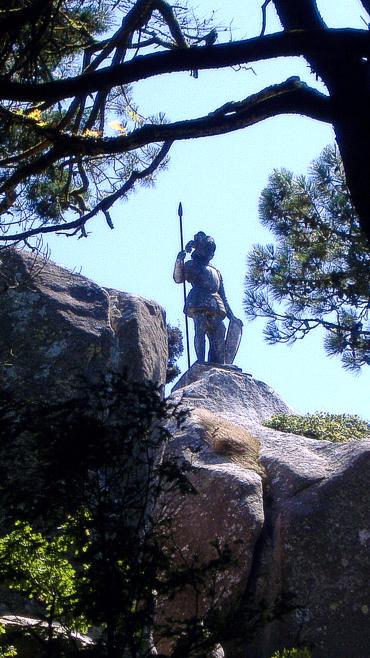
1848 bronze statue from Ernesto Rusconi, believed to be representing Ferdinand guarding his works

Birdview of Pena palace emerging from the clouds
Opening hours
Open all year except December 25th and January 1st
Summer 2018 up to
Palace: From 09:45 until 19:00 - last entry 18:15
Park: From 09:30 until 20:00 - last entry 19:00
Winter 2017-2018 up to
Palace & Park: From 10:00 until 18:00
Accommodation nearby
out of which:
Moon Hill Hostelsee on Google Maps | |
Sintra Boutique Hotel 4see on Google Maps | |
Penha Longa Resort 5see on Google Maps | |
Quinta Velha Guesthousesee on Google Maps |
Getting there
Coordinates: 38.78704911; -9.39030110
Address: Estrada da Pena, 2710-609 Sintra Portugal
4 km from Sintra National Palace (Sintra's historical centre>)
Bus 434 (Pena line)
15 minutes to and from Sintra Train Station
Frequency:
Every 15 minutes, from 09:30 until 18:20
Detailed timetable

Itinerary:
Sintra Train Station > Historic City Centre - Tourist Office - Sintra National Palace > Castle of the Moors > Pena Palace > Historic City Centre - Sintra National Palace > Sintra Train Station
Route Calculator | Scotturb, Cascais Sintra Busses Website
Public transportation in Sintra
€ Prices until Oct 27, 2018
Palace & Park
| Adult (18-64 years) Entry | € 14,00 |
| Child (6-17 years) Entry | € 12,50 |
| Senior (over 65 years) Entry | € 12,50 |
| Family (2 adults + 2 children) Entry | € 49,00 |
Park only
| Adult (18-64 years) Entry | € 7,50 |
| Child (6-17 years) Entry | € 6,50 |
| Senior (over 65 years) Entry | € 6,50 |
| Family (2 adults + 2 children) Entry | € 26,00 |
Related Links
Pena Palace - Wikipedia
King Fernando II of Saxe Coburg-Gotha - Wikipedia
Elise Friedericke Hensler, Countess d'Edla - Wikipedia
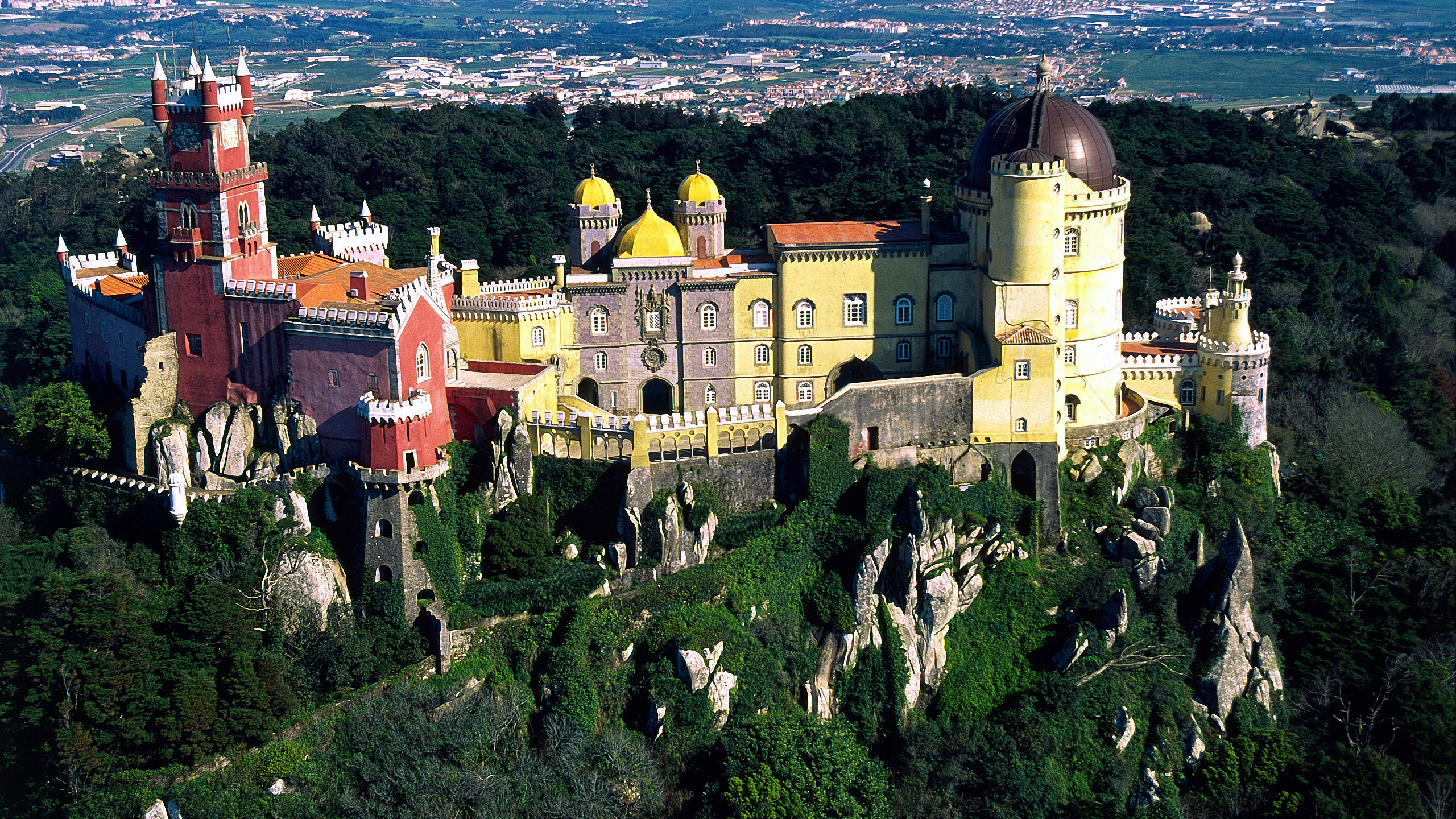
Birdview of Pena National Palace overlooking Sintra's plain
